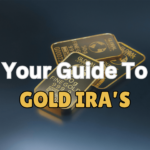
A Step-by-Step Guide
Introduction
In the realm of retirement planning, a Gold IRA rollover stands out as a strategic move that merges the enduring appeal of precious metals with the stability of a tax-advantaged retirement account. This guide explores the benefits of reallocating your savings into a Gold-backed IRA, offering a clear path for those seeking to diversify their long-term portfolio. Focused on preserving wealth and minimizing exposure to market volatility, this approach is more than just a financial transaction—it’s a smart, forward-looking investment strategy.
Why Gold IRA Rollovers Are an Attractive Proposition
In today’s unpredictable financial landscape, safeguarding your retirement savings is more important than ever. Traditional retirement accounts, such as IRAs and 401(k)s, often rely heavily on stocks, bonds, and other paper assets, which can be vulnerable to market volatility and economic downturns. The yellow metal, on the other hand, has a long history of maintaining its value, even during turbulent times. By rolling over your retirement funds into a Gold IRA, you can add a tangible, stable asset to your portfolio that has the potential to grow in value over time.
Moreover, this precious commodity has shown remarkable resilience against inflation, making it an excellent hedge against the erosion of purchasing power. In recent years, its prices have surged, particularly in 2025, when economic uncertainties and geopolitical tensions drove investors to seek safe-haven assets. This surge highlights the potential for significant returns on your investment, making an IRA rollover an attractive proposition for those looking to secure their financial future.
What is a Gold IRA Rollover?
It is a process where funds from a traditional or Roth IRA, a 401(k), or other qualified retirement plans are transferred into a Gold IRA. This allows investors to include physical precious metal in their retirement portfolio, harnessing the metal’s inherent value and stability. Unlike paper assets, it has tangibility and a history of maintaining worth across economic climates, making it a distinctive addition to any retirement strategy.
Why Consider a Gold IRA Rollover?
The decision to roll over funds into a Gold IRA is often driven by a desire to diversify investments and hedge against economic uncertainties. The metal has historically maintained its value, even during periods of inflation and economic downturns. By including it in your retirement portfolio, you’re adding an asset that can potentially grow in value when other investments might not. Over the past decade, its prices have shown significant growth, with notable spikes during periods of economic instability.
For instance, during the 2008 financial crisis, prices surged as investors sought safer investments. Similarly, the economic uncertainty caused by the COVID-19 pandemic saw values reach new highs, highlighting its role as a hedge against economic instability. In 2025, prices hit record highs, driven by global economic uncertainties and geopolitical tensions.
Benefits of Gold IRA Rollovers
Hedge Against Economic Uncertainty
This precious metal has long been a safe-haven asset, often increasing in value when economies face turbulence. By rolling over funds into a Gold IRA, you’re positioning your retirement savings to potentially grow during times of economic downturn, providing a buffer against market volatility. For instance, during the 2008 financial crisis, prices surged as investors sought safer investments. Similarly, the economic uncertainty caused by the COVID-19 pandemic saw values reach new highs, highlighting its role as a hedge against economic instability. In 2025, prices hit record highs, driven by global economic uncertainties and geopolitical tensions.
Portfolio Diversification

Diversification is a cornerstone of robust investment strategies. A Gold IRA Rollover introduces an alternative asset class to your retirement portfolio, reducing reliance on stocks and bonds. This move can stabilize your portfolio, as the yellow metal typically exhibits a low correlation with other financial instruments. When the stock market is performing well, it might not show significant gains, but it can protect your portfolio during market downturns.
Historical data shows that diversified portfolios with this asset have often experienced less volatility compared to those without. For example, during the stock market crash of 2008, prices rose, providing a cushion for diversified portfolios. In the 2020s, as the market rose, the metal continued its unexpected upward trajectory. This lack of correlation means that when other assets are underperforming, it may hold its value or even appreciate, smoothing out portfolio returns over time.
Inflation Hedge
Historically, the yellow metal has shown resilience against inflation, maintaining its purchasing power over time. As inflation erodes the value of paper currency, its value has often risen, offering protection for your retirement savings in inflationary periods. For example, during the high inflation period of the 1970s, prices increased significantly, outpacing inflation rates and preserving wealth for investors. In recent years, it has continued to demonstrate its inflation-hedging capabilities. Between 2010 and 2020, values increased by approximately 180%, significantly outpacing the average inflation rate during that period. This long-term trend underscores its effectiveness as an inflation hedge, making it a valuable addition to any retirement portfolio.
Potential for Long-Term Growth
This metal has demonstrated consistent long-term growth, with periods of significant appreciation. Including it in your retirement portfolio can enhance growth potential, contributing to a more substantial nest egg over time. Over the past few decades, prices have seen substantial increases, with some periods of remarkable growth. The long-term trend for this asset has been upward, making it a valuable addition for retirement portfolios seeking steady growth.
Historical Performance of Gold
Its historical performance underscores its potential for long-term growth. For instance, from 2000 to 2020, prices increased by over 500%, significantly outperforming many traditional investment assets. This period includes several economic cycles, demonstrating gold’s resilience and growth potential across different market conditions.
- 2000–2010: During the first decade of the 2000s, prices saw a steady increase, driven by economic uncertainties and the global financial crisis. The price more than doubled during this period, from around $275 per ounce in 2000 to over $1,000 per ounce by 2010.
- 2010–2020: The second decade saw even more significant growth. Prices continued to rise, reaching new highs in 2020. By the end of this decade, values had increased by over 200%, highlighting its potential for substantial returns.
Factors Driving Gold’s Long-Term Growth
Several factors contribute to this metal’s long-term growth potential:
- Economic Uncertainty: It is often seen as a safe-haven asset during times of economic uncertainty. When traditional markets are volatile, investors turn to it to preserve their wealth. This demand drives up the price.
- Inflation: It has historically maintained its value during inflationary periods. As the value of fiat currencies erodes, its purchasing power remains stable or increases.
- Geopolitical Tensions: Geopolitical tensions and uncertainties also drive up the demand. Investors seek the stability and reliability of the metal during times of political instability or conflict.
- Supply Constraints: The supply is limited and increases only gradually. As demand grows, especially from emerging markets, the price tends to rise.
Case Studies and Examples
- 2008 Financial Crisis: During the 2008 financial crisis, prices surged as investors sought safe-haven assets. The price increased significantly, providing a buffer against the market downturn.
- COVID-19 Pandemic: The economic uncertainty caused by the COVID-19 pandemic led to another surge in values. Investors turned to this precious asset as a stable investment.
- 2025 Surge: In 2025, prices hit record highs, driven by global economic uncertainties and geopolitical tensions. This surge highlights its role as a hedge against economic instability.
Tax Advantages

Gold IRA Rollovers offer tax benefits, allowing for tax-deferred growth of your investments. Contributions to a traditional Gold IRA may be tax-deductible, and taxes on withdrawals are typically deferred until retirement, potentially reducing your tax burden. Roth Gold IRA contributions are made with after-tax dollars, but qualified withdrawals in retirement are tax-free.
This tax advantage can enhance the overall returns of your retirement investments. For example, if you contribute to a traditional Gold IRA, you may be able to deduct your contributions from your taxable income, reducing your current tax liability. Additionally, the growth of your investments within the IRA is tax-deferred, meaning you won’t pay taxes on the gains until you withdraw the funds in retirement. This can lead to significant tax savings over time, allowing your investments to grow more quickly.
How to Perform a Gold IRA Rollover: Step-by-Step Process

Step 1: Choose a Gold IRA Custodian
Selecting the right custodian is crucial. Research custodians with experience in precious metals IRAs, checking for credibility, fees, and customer service. Ensure they offer the specific types of yellow metal investments you’re interested in. Look for custodians with a proven track record in managing Gold IRAs and providing reliable services. Reading reviews and comparing fee structures can help you make an informed decision. Some key factors to consider when choosing a custodian include:
- Experience and Reputation: Choose a custodian with a long history of managing precious metal IRAs and a strong reputation in the industry.
- Fees: Compare the fees charged by different custodians, including setup fees, storage fees, and transaction fees.
- Investment Options: Ensure the custodian offers a wide range of metal investment options, such as bullion, coins, and certified bars.
- Customer Service: Look for a custodian with excellent customer service, including responsive support and helpful resources.
Step 2: Open a Gold IRA Account
Once you’ve chosen a custodian, open a Gold IRA account. This process is similar to opening a traditional IRA and can often be completed online. Provide necessary personal and financial information. The custodian will guide you through the account opening process, which typically involves filling out forms and providing identification documents. During the account opening process, you’ll need to provide information such as your Social Security number, employment status, and financial details. The custodian may also require proof of identity, such as a driver’s license or passport. Once your account is open, you’ll receive a welcome kit with additional information and instructions for funding your account.
Step 3: Fund the Gold IRA
You can fund your Gold IRA through a rollover from an existing retirement account. This can be done as a direct rollover from your current custodian to the new Gold IRA custodian or as a 60-day indirect rollover where you receive the funds and then transfer them to the new account. A direct rollover is often smoother and avoids potential tax issues, while an indirect rollover requires careful timing to avoid tax penalties.
To perform a direct rollover, you’ll need to contact your current custodian and request a transfer of funds to your new Gold IRA custodian. The custodian will handle the transfer process, ensuring that the funds are moved directly from one account to the other. If you choose an indirect rollover, you’ll receive the funds directly and have 60 days to deposit them into your new IRA. Failure to complete the rollover within this timeframe may result in tax penalties and withholding.
Step 4: Purchase Gold
After funding your Gold IRA, instruct your custodian to purchase the metal on your behalf. The precious metal will be held in a secure depository approved by the custodian. You can choose from various types of investments, such as bullion, coins, or certified bars. The custodian will handle the purchase and storage arrangements, ensuring that the metal meets the requirements for inclusion in an IRA. When purchasing, consider the following:
- Type of Metal: Choose between bullion, coins, or certified bars based on your investment goals and preferences.
- Purity and Certification: Ensure the precious metal meets the required purity standards and is certified by a reputable organization.
- Storage: The metal will be stored in a secure depository approved by the custodian, ensuring its safety and security.
Step 5: Manage Your Gold IRA
Monitor your Gold IRA and make adjustments as needed. Your custodian can provide guidance on managing your account and may offer tools for tracking performance. Regularly reviewing your IRA’s performance and making necessary adjustments can help you stay on track with your retirement goals. Consider the following tips for managing your account:
- Regular Reviews: Schedule regular reviews of your Gold IRA’s performance to ensure it aligns with your retirement goals.
- Adjustments: Make adjustments to your portfolio as needed, based on market conditions and your financial situation.
- Communication: Maintain open communication with your custodian to stay informed about your account and any changes that may impact your investments.
Tax Implications of Gold IRA Rollovers
Understanding the tax implications is vital. Traditional precious metal IRA contributions may be tax-deductible, and taxes on earnings are deferred until withdrawal. Roth IRAs funded with after-tax dollars allow qualified withdrawals to be tax-free. Always consult with a tax professional to navigate these aspects effectively. Being aware of the tax implications can help you maximize the benefits of your metal-backed IRA and avoid any potential issues. Some key considerations include:
- Tax-Deductible Contributions: Contributions to a traditional IRA that holds precious metals may reduce your taxable income for the year.
- Tax-Deferred Growth: Earnings within the IRA grow tax-deferred, meaning you won’t owe taxes until you make withdrawals during retirement.
- Tax-Free Withdrawals: Qualified withdrawals from a Roth account are tax-free, offering a tax-efficient way to access your metal investment returns later in life.
- Early Withdrawal Penalties: Withdrawing funds before age 59½ may lead to a 10% penalty, along with regular income taxes.
Conclusion
Incorporating gold into your retirement portfolio not only adds security but also opens the door to long-term value preservation and growth. As you move forward with the rollover process, remember these key takeaways:
Diversification
Adding physical metal to your portfolio acts as a hedge against economic uncertainty and market fluctuations. By diversifying your investments, you reduce reliance on traditional assets like stocks and bonds, which can be volatile. Gold’s low correlation with these assets means it can stabilize your portfolio, providing a buffer during market downturns. This diversification strategy helps protect your wealth and ensures more consistent returns over time.
Inflation Protection
Gold has historically held its value during periods of inflation, making it a reliable store of wealth. Unlike paper currencies, which can lose value as inflation rises, gold maintains its purchasing power. For example, during the high inflation periods of the 1970s, gold prices surged, outpacing inflation rates and preserving wealth for investors. Including gold in your retirement portfolio can protect your savings from the erosive effects of inflation, ensuring that your nest egg retains its value over time.
Tax Benefits
Utilize both traditional and Roth structures to manage your tax exposure effectively. Traditional Gold IRA contributions may be tax-deductible, reducing your taxable income in the year of contribution. Earnings within a traditional Gold IRA grow tax-deferred, meaning you won’t pay taxes on the gains until you withdraw the funds in retirement. Roth Gold IRA contributions are made with after-tax dollars, but qualified withdrawals in retirement are tax-free, providing a significant advantage for those looking to minimize their tax burden. By strategically using these structures, you can optimize your tax situation and maximize your retirement savings.
Professional Guidance
Collaborate with trusted custodians, tax professionals, and financial advisors to make well-informed decisions. The process of rolling over funds into a Gold IRA involves several steps and considerations, from choosing the right custodian to understanding tax implications. Working with experienced professionals ensures that you navigate this process smoothly and avoid potential pitfalls. They can provide valuable insights, help you make informed decisions, and tailor your investment strategy to your specific financial goals and circumstances.
Final Thoughts
By leveraging these insights and using the steps outlined here, you can confidently execute a Gold IRA rollover and potentially build a more resilient and future-ready retirement portfolio. Gold’s unique properties as a tangible asset, its historical performance, and its role as a hedge against economic uncertainty make it a compelling addition to any retirement strategy. Whether you’re looking to preserve wealth, seek potential returns, or simply add stability to your portfolio, a Gold IRA rollover can be a strategic move towards securing your financial future.
FAQs
Additional Information and Resources
For those looking to delve deeper into Gold IRA rollovers, consider exploring the following resources:
- Investopedia: A comprehensive guide on Gold IRA rollovers, covering the benefits, process, and tax implications.
- IRS Guidelines: Direct information from the Internal Revenue Service on IRA rollovers and the specific rules governing Gold IRAs.
- smartgoldretirement: Research and compare different custodians to find one that meets your specific needs and investment goals.
By taking advantage of these resources and following the step-by-step guide provided, you can confidently navigate the process of performing a Gold IRA rollover and potentially enhance your retirement portfolio with the stability and growth potential that gold offers.







